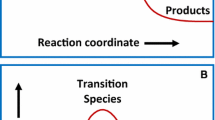Abstract
We expand the biogeochemical model CCBATCH to include a precipitation/dissolution sub-model that contains kinetic and equilibrium options. This advancement extends CCBATCH's usefulness to situations in which microbial reactions cause or are affected by formation or dissolution of a solid phase. The kinetic option employs a rate expression that explicitly includes the intrinsic kinetics for reaction ormass-transport control, the differencefrom thermodynamic equilibrium, and the aqueous concentration of the rate-limiting metal or ligand. The equilibrium feature can be used alone, and it also serves as check that the kinetic rate never is too fast and ``overshoots'' equilibrium. The features of the expanded CCBATCH are illustrated by an example in which the precipitation of Fe(OH)3 (s) allows the biodegradation of citric acid, even though complexes are strong and not bioavailable. Precipitation releases citrate ligand, and biodegradation of the citrate increases the pH.
Similar content being viewed by others
References
Bae W & Rittmann BE (1996) A structured model of dual-limitation kinetics. Biotechnol. Bioeng. 49: 683-689
Banaszak JE (1999) Coupling microbial and mineral-phase reactions. PhD dissertation, Dept. Civil Eng., Northwestern Univ., Evanston, Illinois
Bethke CM (1992) The geochemists' workbench, a users' guide to Rxn, act 2, tact, react. and Gtp[lot]. Dept. of Geology, University of Illinois at Urbana-Champaign, Urbana, Illinois.
Borse GJ (1991) FORTRAN 77 and numerical methods for engineers, 2nd edn, PWS-KENT Publishing Co., Boston.
Brady PV & House WA (1996) Surface-controlled dissolution and growth of minerals. In: PV Brady (Ed), Physics and Chemistry of Mineral Surfaces (pp. 225-306). CRC Press, Boca Raton, Florida
Brady PV & Zachara JM (1996) Geochemical applications of mineral surface science. In: PV Brady (Ed), Physics and Chemistry of Mineral Surfaces, (pp. 307-356). CRC Press, Boca Raton, Florida
Flint RA (1963) Fundamentals of Metal Casting, Addison-Wesley Co., Reading, Massachusetts
Hamm RE, Shull CMJ & Grant DM (1954) Citrate complexes with iron (II) and iron (III). J. Amer. Chem. Soc. 76: 2111-2114
Jordan, AD & Rammensee W (1996) Dissolution rates and activation energy for dissolution of brucite (001): a new method based on the microtopography of crystal surfaces. Geochimica et Cosmochimica Acta 60: 5055-5062
Joshi-Topé G & Francis AJ (1995) Mechanisms of biodegradation of metal-citrate complexes by Pseudomonas fluorescens. J. Bacteriology 177: 1989-1993
Kinzelbach W, Schäfer W & Herzer J (1991) Numerical modeling of natural and enhanced denitrification processes in aquifers. Water Resource Res. 27: 1123-1135
Lasaga AC (1995) Fundamental approaches in describing mineral dissolution and precipitation rates. In: AF White & SL Brantley (Eds), Chemical Weathering Rates of Silicate Minerals Cycles. Mineralogical Soc. Amer. 31: 21-86
Lasaga AC, Soler, JM, Ganor, J, Burch, TE & Nagy KL (1994) Chemical weathering rate laws and global geochemical cycles. Geochemica et Cosmochimica Acta 58: 2361-2386
Lichtner PC (1985) Continuum model for simultaneous chemical reactions and mass transport in hydrothermal systems. Geochemica et Cosmochimica Acta 49: 779-800
Lichtner PC (1996) Continuum formulation of multicomponentmultiphase reactive transport. In: PC Lichtner, CI Steefel & EH Oelkers (Eds), Rev. in Mineralogy, Vol. 34: Reactive Transport in Porous Media. Mineralogical Soc. Amer
Lovley DR (1991) Dissimilatory Fe(III) and Mn(IV) reduction. Microbial. Rev. 55: 259-287
Madigan MT, Martinko JM & Parker J (2000) Brock Biology of Microorganisms, 9th ed., Prentice-Hall, Inc., Upper Saddle Ridge, New Jersey
McCarty PL (1972) Energetics of organic matter degradation. In: R. Mitchell (Ed), Water Pollution Microbiology (pp. 98-118). John Wiley & Sons, Inc., New York
Morel FMM & Hering JG (1993) Principles and Applications of Aquatic Chemistry, John Wiley & Sons, Inc., New York
Morel FMM & Morgan J (1972) A numerical method for computing equilibria in aqueous chemical systems. Environ. Sci. Technol. 6: 58-67
Myers CR & Myers JM (1993) Ferric reductase is associated with the membranes of anaerobically grown Shewanella putrafaciens. FEMS Microb. Letters 108: 127-131
Paquette J & Reeder RJ (1995) Relationship between surface structure, growth mechanism and trace element incorporation in calcite. Geochemica et Cosmochimica Acta 59: 735-749
Press WH, Teukolsky SA, Vettering WT & Flannery BP (1992) Numerical Recipes in FORTRAN: The Art of Scientific Computing. Cambridge University Press, New York
Rittmann BE & McCarty PL (2001) Environmental Biotechnology: Principles and Applications. McGraw-Hill Book Co., New York
Rittmann BE & VanBriesen JM (1996) Microbiological processes in reactive transport modeling. In: PC Lichtner, CI Steefel & EH Oelkers (Eds), Reactive Transport in Porous Media, Vol. 34 (pp. 311-334). Mineralogical Soc. Amer., Washington, DC
Stumm W & Morgan JJ (1996) Aquatic Chemistry, 3rd edn John Wiley & Sons, Inc., New York
VanBriesen JM & Rittmann BE (1999) Modeling speciation effects on biodegradation in mixed metal/chelate systems. Biodegradation 10: 315-330
VanBriesen JM & Rittmann BE (2000) Mathematical description of microbiological reactions involving intermediates. Biotechnol. Bioengr. 67: 18-52.
Author information
Authors and Affiliations
Rights and permissions
About this article
Cite this article
Rittmann, B.E., Banaszak, J.E., VanBriesen, J.M. et al. Mathematical modeling of precipitationand dissolution reactions in microbiological systems. Biodegradation 13, 239–250 (2002). https://doi.org/10.1023/A:1021225321263
Issue Date:
DOI: https://doi.org/10.1023/A:1021225321263




